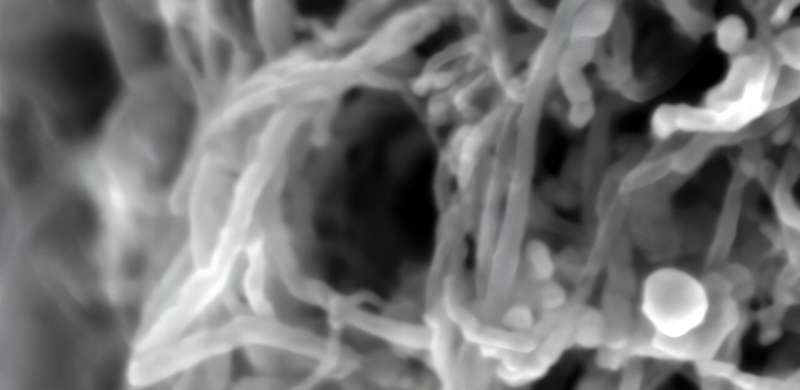Science
Researchers Develop Sustainable Method for Giant Fullerene Synthesis

A team of researchers from the University of São Paulo (USP) in Brazil and the Università degli Studi di Roma “La Sapienza” in Italy has successfully synthesized fullerenes and hollow graphene particles using an innovative electrochemical method. This breakthrough, published in the journal Diamond and Related Materials on July 17, 2025, demonstrates a more sustainable approach to producing these complex carbon structures, which have significant potential in various technological applications.
The research reveals that fullerenes, including larger variants known as “giant fullerenes” containing up to 190 carbon atoms, can be created from basic materials such as natural graphite, ethanol, water, and sodium hydroxide at ambient conditions. José Mauricio Rosolen, a researcher at USP and the study’s coordinator, emphasizes that this process eliminates the need for high temperatures, which typically range from 3,000 °C to 4,000 °C, making it a more accessible and environmentally friendly alternative.
Fullerenes are unique spherical molecules composed entirely of carbon atoms. The most recognized example, C60, is often referred to as “buckminsterfullerene,” named after the American architect Buckminster Fuller due to its resemblance to his geodesic dome designs. Since their discovery in 1985, fullerenes have garnered attention for their remarkable electronic and structural properties, including their detection in outer space by NASA in 2010.
In this study, the researchers utilized anodic polarization of graphite within an electrochemical cell to encourage the formation of oxidized graphene sheets. These sheets then spontaneously self-assemble into fullerenes and hollow spheres. The final products were thoroughly characterized using advanced techniques including scanning electron microscopy (SEM), atomic force microscopy (AFM), and mass spectrometry.
Rosolen notes that the research uncovered spherical particles varying in size from 10 nanometers to 320 nanometers, with larger structures trapped within networks of carbon nanotubes. Mass spectrometry further identified characteristic peaks corresponding to well-studied fullerenes such as C60 and C70, as well as larger fullerenes like C146, C162, C176, and C190. The presence of successive peaks, separated by approximately 160 units, indicates fragmentation processes likely due to the loss of carbon groups.
The research highlights the critical role of hydroxyl radicals and hydroxyl ions generated from the electrochemical oxidation of water and ethanol. These radicals facilitate the fragmentation of graphite sheets, promoting exfoliation and leading to fullerene formation. Rosolen explains that when the applied voltage exceeds 10 volts, the synthesis of fullerenes declines significantly, with carbon nanodots becoming the dominant structure.
This innovative method not only simplifies the production of fullerenes but also allows for potential modifications through the incorporation of oxygenated functional groups, depending on intended applications. The researchers believe that their findings pave the way for new avenues in organic synthesis and technological applications that have yet to be fully explored.
“Our work opens up the possibility of producing giant fullerenes through an accessible and environmentally friendly electrochemical route,” Rosolen says. “While much remains to be understood about the formation mechanisms of these structures, the results are promising and lay the groundwork for future research.”
This advancement not only represents a significant step forward in materials science but also underscores the potential for sustainable practices in the production of advanced materials. The implications of this research could extend across various fields, from nanotechnology to pharmaceuticals, enhancing the versatility and application of fullerenes in modern science.
-

 Technology4 months ago
Technology4 months agoDiscover the Top 10 Calorie Counting Apps of 2025
-

 Health2 months ago
Health2 months agoBella Hadid Shares Health Update After Treatment for Lyme Disease
-

 Health3 months ago
Health3 months agoErin Bates Shares Recovery Update Following Sepsis Complications
-

 Technology3 weeks ago
Technology3 weeks agoDiscover 2025’s Top GPUs for Exceptional 4K Gaming Performance
-

 Technology2 months ago
Technology2 months agoElectric Moto Influencer Surronster Arrested in Tijuana
-

 Technology4 months ago
Technology4 months agoDiscover How to Reverse Image Search Using ChatGPT Effortlessly
-

 Technology4 months ago
Technology4 months agoMeta Initiates $60B AI Data Center Expansion, Starting in Ohio
-

 Technology4 months ago
Technology4 months agoRecovering a Suspended TikTok Account: A Step-by-Step Guide
-

 Health4 months ago
Health4 months agoTested: Rab Firewall Mountain Jacket Survives Harsh Conditions
-

 Lifestyle4 months ago
Lifestyle4 months agoBelton Family Reunites After Daughter Survives Hill Country Floods
-

 Technology3 months ago
Technology3 months agoUncovering the Top Five Most Challenging Motorcycles to Ride
-

 Technology4 weeks ago
Technology4 weeks agoDiscover the Best Wireless Earbuds for Every Lifestyle









